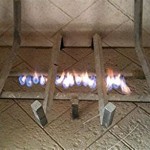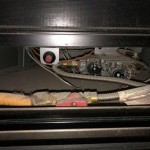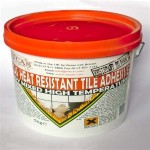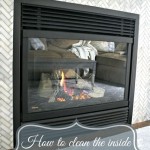How To Paint a Fireplace Surround White
Painting a fireplace surround white is a popular home improvement project that can significantly brighten a room and update its aesthetic. A white fireplace surround offers a clean, classic look that complements various interior design styles. Whether the existing surround is brick, wood, stone, or tile, proper preparation and painting techniques are crucial for achieving a professional and durable finish. This article provides a comprehensive guide to painting a fireplace surround white, covering the necessary materials, preparation steps, painting process, and considerations for different surround materials.
Preparation is Key to a Lasting Finish
The success of any paint job hinges on thorough preparation. Neglecting this step can lead to poor adhesion, uneven coverage, and a finish that is prone to chipping and peeling. The preparation process varies slightly depending on the existing material of the fireplace surround, but the fundamental principles remain the same: cleaning, repairing, and priming.
Cleaning the Fireplace Surround: The first step is to meticulously clean the fireplace surround. Over time, fireplace surrounds accumulate soot, dust, grime, and potentially grease. These contaminants can interfere with paint adhesion, leading to unsatisfactory results. Start by using a stiff brush or vacuum cleaner with a brush attachment to remove loose debris. For soot and grime, a mixture of warm water and mild detergent is effective. Use a sponge or cloth to scrub the surface, paying particular attention to crevices and grout lines. For stubborn stains, consider using a specialized cleaner designed for the specific material of the surround (e.g., brick cleaner for brick surrounds). Rinse the surface thoroughly with clean water to remove any soap residue. Allow the surround to dry completely before proceeding to the next step.
Repairing Damage: Before painting, it is essential to address any existing damage to the fireplace surround. Cracks, chips, and loose mortar should be repaired to ensure a smooth and uniform surface. For brick or stone surrounds, use mortar or patching compound to fill in cracks and gaps. Follow the manufacturer's instructions for mixing and applying the repair material. After the mortar has dried, sand it smooth to blend with the surrounding surface. For wood surrounds, use wood filler to repair cracks and chips. Sand the filler smooth after it has dried. For tiled surrounds, replace any broken or missing tiles and regrout as needed. Ensure that all repairs are completely dry and cured before proceeding to priming.
Masking and Protecting the Area: Protect surrounding surfaces from paint splatters by using painter's tape and drop cloths. Mask off the firebox opening, the adjacent walls, the floor, and any decorative elements that are not being painted. Use high-quality painter's tape to create clean, sharp lines. Secure drop cloths to the floor and adjacent surfaces to prevent paint from staining. Consider using plastic sheeting to cover furniture or other items that cannot be easily moved away from the fireplace.
Sanding the Surface: Sanding is an important step, especially for surfaces that are glossy or have an existing finish. Sanding creates a slightly rough surface that allows the primer to adhere more effectively. Use medium-grit sandpaper (e.g., 120-grit) to lightly sand the entire surface of the fireplace surround. Focus on areas with existing paint or varnish. After sanding, use a tack cloth or vacuum cleaner to remove any sanding dust. For brick or stone surrounds, a wire brush can be used to roughen the surface and remove loose particles.
Priming the Fireplace Surround: Priming is a crucial step that ensures proper paint adhesion, seals the surface, and provides a uniform base for the topcoat. Choose a primer that is appropriate for the material of the fireplace surround. For brick and stone, use a masonry primer; for wood, use a wood primer; and for tile, use a bonding primer. Apply the primer according to the manufacturer's instructions, using a brush, roller, or sprayer. Allow the primer to dry completely before proceeding to the next step. In some cases, a second coat of primer may be necessary, especially if the existing surface is dark or porous. If a second coat of primer is applied, allow it to dry completely before painting.
Selecting the Right Paint and Tools
Choosing the right paint and tools is essential for achieving a professional-looking and durable finish. Not all paints are created equal, and the specific requirements of a fireplace surround demand a paint that can withstand heat, moisture, and frequent cleaning. Similarly, using the appropriate brushes, rollers, and other tools will significantly impact the quality and efficiency of the painting process.
Choosing the Right Paint: For painting a fireplace surround white, a high-quality latex paint is generally recommended. Latex paints are durable, easy to clean, and available in a wide range of sheens. For fireplace surrounds, a semi-gloss or satin finish is often preferred, as these sheens are more resistant to stains and easier to wipe clean than matte finishes. Consider using a paint that is specifically formulated for high-traffic areas or for use on trim and doors, as these paints tend to be more durable and resistant to wear and tear. Ensure the chosen paint is suitable for the material of the fireplace surround. In some cases, a specialized paint may be required (e.g., heat-resistant paint for areas near the firebox opening). Always read the manufacturer's instructions and recommendations before purchasing paint.
Selecting the Right Tools: The tools required for painting a fireplace surround include brushes, rollers, paint trays, and potentially a paint sprayer. Choose high-quality brushes with synthetic bristles for applying paint to intricate areas and corners. Use a roller with a nap length appropriate for the surface texture of the surround. For smooth surfaces, a short nap roller is recommended; for textured surfaces, a longer nap roller may be necessary. Use a paint tray with a liner for easy cleanup. If using a paint sprayer, ensure that it is properly adjusted and that you are familiar with its operation. Other essential tools include painter's tape, drop cloths, a putty knife (for repairing damage), sandpaper, a tack cloth, and safety glasses.
Calculating Paint Quantity: Estimate the amount of paint required based on the surface area of the fireplace surround. Measure the height and width of the surround and multiply these dimensions to calculate the area. Consider adding a buffer for waste and multiple coats. A general rule of thumb is that one gallon of paint covers approximately 350-400 square feet. When calculating paint quantity, also factor in the primer needed. It is always better to have a little extra paint on hand than to run out mid-project.
Applying the Paint for a Flawless Finish
The application of paint is the final and most visible stage of the process. Proper technique is essential for achieving a smooth, even, and professional-looking finish. Patience and attention to detail are key to ensuring that the paint is applied correctly and that the final result is aesthetically pleasing and durable.
Applying the First Coat: Begin by applying the first coat of paint to the fireplace surround. Use a brush to paint the edges and corners, a technique known as "cutting in." This creates a clean, defined line. Then, use a roller to apply paint to the larger, flat surfaces. Apply the paint in thin, even coats, overlapping each stroke slightly to avoid streaks and uneven coverage. Avoid applying too much paint at once, as this can lead to drips and runs. Work in small sections at a time, ensuring that the paint is evenly distributed. If using a paint sprayer, hold the sprayer at a consistent distance from the surface and move it in smooth, even strokes. Allow the first coat of paint to dry completely before proceeding to the next step. Consult the paint manufacturer's instructions for recommended drying times.
Sanding Between Coats (Optional): After the first coat of paint has dried, inspect the surface for any imperfections, such as drips, runs, or brushstrokes. If necessary, lightly sand the surface with fine-grit sandpaper (e.g., 220-grit) to smooth out these imperfections. Be careful not to sand through the paint layer. After sanding, use a tack cloth to remove any sanding dust. Sanding between coats can improve the smoothness and uniformity of the final finish, but it is not always necessary.
Applying the Second Coat: Apply a second coat of paint to the fireplace surround, using the same techniques as before. Ensure that the first coat is completely dry before applying the second coat. The second coat will provide better coverage and durability. Again, apply the paint in thin, even coats, overlapping each stroke slightly. Pay attention to any areas that may have been missed during the first coat. Allow the second coat of paint to dry completely before removing the painter's tape and drop cloths.
Removing Tape and Cleaning Up: Carefully remove the painter's tape while the paint is still slightly wet. This will help to prevent the paint from peeling or chipping along the edges. Use a utility knife to score the paint along the edge of the tape before removal to ensure a clean line. Remove the drop cloths and dispose of them properly. Clean up any spills or splatters immediately with a damp cloth. Clean brushes and rollers with soap and water, or with the appropriate solvent for the type of paint used. Allow the fireplace surround to dry completely before using the fireplace.
By following these detailed steps, it is possible to achieve a professional-looking white finish on a fireplace surround, enhancing the aesthetic appeal of the room and creating a focal point that is both beautiful and durable. Remember to prioritize preparation, select the right materials, and apply the paint with care and attention to detail.

Painting Your Oak Mantel White Fireplace Wood Surrounds

My Fireplace Mantel Reveal A Makeover With Paint Setting For Four Interiors

How To Paint Your Fireplace Brick Surround

My Fireplace Mantel Reveal A Makeover With Paint Setting For Four Interiors

My Fireplace Mantel Reveal A Makeover With Paint Setting For Four Interiors

Lessons From A White Painted Fireplace Makeover The Inspired Room

Paint A Fireplace To Look Like Cast Stone Porch Daydreamer

Guide To Fireplace Painting Part 2 Colors And Techniques

How To Paint A Brick Fireplace Young House Love

How To Paint A Wooden Fireplace Surround








